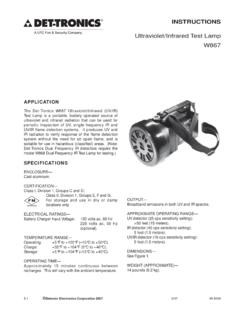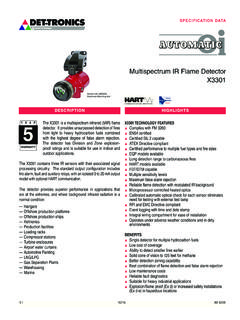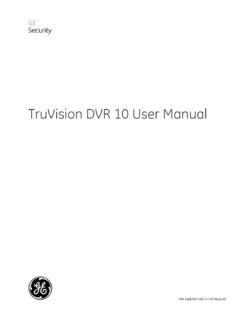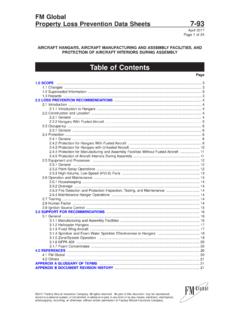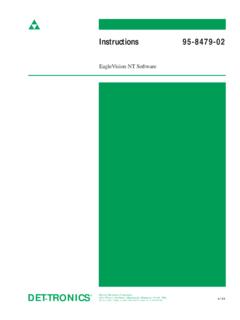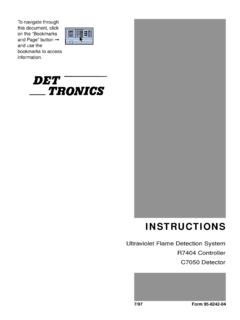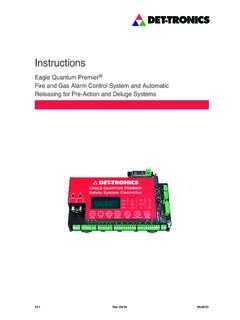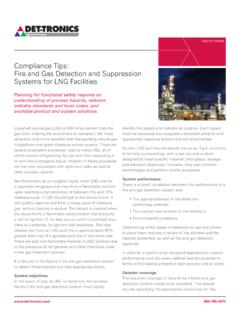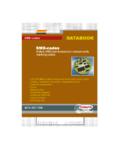Transcription of DET TRONICS
1 DET- TRONICS INSTRUCTIONSE agle 2000 Hazard Event Monitoring System7/99 Form 95-8424-02 With the trend toward increasingly widespread use ofmicroprocessors and a wide variety of other electro-static sensitive semiconductor devices, the need forcareful handling of equipment containing thesedevices deserves more attention than it has receivedin the damage can occur in several ways. Themost familiar is by physical contact. Touching anobject causes a discharge of electrostatic energy thathas built up on the skin. If the charge is of sufficientmagnitude, a spark will also be visible. This voltageis often more than enough to damage some electroniccomponents. Some devices can be damaged withoutany physical contact. Exposure to an electric fieldcan cause damage if the electric field exceeds thedielectric breakdown voltage of the capacitive ele-ments within the some cases, permanent damage is instantaneousand an immediate malfunction is realized.
2 Often,however, the symptoms are not immediatelyobserved. Performance may be marginal or evenseemingly normal for an indefinite period of time, fol-lowed by a sudden and mysterious caused by electrostatic discharge can bevirtually eliminated if the equipment is handled only ina static safeguarded work area and if it is transportedin a package or container that will render the neces-sary protection against static modules that might be damaged by staticelectricity are carefully wrapped in a static protectivematerial before being packaged. Foam packagingblocks are also treated with an antistatic it should ever become necessary to return the mod-ule, it is highly recommended that it be carefullypackaged in the original carton and static a static safeguarded work area is usuallyimpractical in most field installations, caution shouldbe exercised to handle the module by its metalshields, taking care not to touch electronic compo-nents or general, always exercise all of the accepted andproven precautions that are normally observed whenhandling electrostatic sensitive warning label is placed on the packaging, identify-ing those units that use electrostatic sensitive semi-conductor devices.
3 Detector Electronics Corporation 1982 8/8275-1005 SERVICE MEMOP recautions for HandlingElectrostatic Sensitive Devices*Published in accordance with EIA Standard 471*Detector Electronics Corporation6901 West 110th Street Minneapolis, Minnesota 55438 USA Facsimile (612) 829-8750 Telephone (612) 941-5665 or (800) 765-FIRE Telex 6879043 DETEL UW Cable DETRONICS Printed in USA Table of ContentsSECTION ISYSTEM OVERVIEW APPLICATION ..1 FEATURES ..1 SYSTEM DESCRIPTION ..1 Detector ..1 Communication Gateway EA2100CG ..2 Communication Module EA2300CM ..2 Digital Communication Unit EA2200 DCU ..2 Network Extender EA2400NE ..3 Relay Module EA2500RM ..3 NETWORK OPERATION DURING A FAULTCONDITION ..3 SECTION IIEA2300 CMCOMMUNICATION MODULE APPLICATION ..4 FEATURES ..4 SPECIFICATIONS ..4 DESCRIPTION ..5 Addressability ..5 Status LED s ..5 Outputs.
4 6 Inputs ..6 Reed Switch ..6 Event Logging ..6 Fault Tolerant Network ..6 Enclosure ..6 Terminal Wiring Board ..6 SECTION IIIEA2200 DCU DIGITAL COMMUNICATION UNITAPPLICATION ..7 FEATURES ..7 SPECIFICATIONS ..7 DESCRIPTION ..8 Enclosure ..8 DCU Circuit Boards ..8 SECTION IVEA2100 CGCOMMUNICATION GATEWAYAPPLICATION ..9 FEATURES ..9 SPECIFICATIONS ..9 DESCRIPTION ..9 Main Gateway ..9 Auxiliary Gateway ..10 Faceplate Description ..10 LEDs ..11 Relays ..11 Automatic Diagnostics ..11 Fault Tolerant Communication ..12 System Capacity ..12 Installation ..12 SECTION V EA2400 NENETWORK EXTENDERAPPLICATION ..12 FEATURES ..12 SPECIFICATIONS ..12 DESCRIPTION ..13 Automatic Diagnostics ..13 Enclosure ..13 GENERAL INFORMATION ..13 System Capacity ..13 Temperature Limitations ..13 Response Time Versus System Size ..14 SECTION VI EA2500 RMRELAY MODULE APPLICATION.
5 14 FEATURES ..14 SPECIFICATIONS ..14 DESCRIPTION ..15 Conditions for Relay Actuation ..15 Operating Modes ..15 Inputs ..15 Outputs ..15 Status Update ..15 Addressability ..16 Event Logging ..16 Status LEDs ..16 Fault Tolerant Network ..16 Wiring ..16 Enclosure ..16 SECTION VII SYSTEM INSTALLATION GENERAL WIRING REQUIREMENTS ..16 DETERMINING GAUGE OF POWER WIRING ..17 COMMUNICATION MODULE AND DCU WIRING ..19 TYPICAL APPLICATIONS ..19 GATEWAY WIRING ..20 Gateway Switch Settings ..20 INSTALLATION CHECKLIST ..27 SECTION VIII SYSTEM STARTUPSTARTUP PROCEDURE ..28 SYSTEM CONFIGURATION ..28 CALIBRATION ..28 CALIBRATION ALGORITHMS ..28 Calibration Algorithm A (Type Codes 1, 2, 3, 4) for Gas Detectors ..29 Calibration Algorithm A (Type Codes 1, 2, 3, 4)for Environmental Monitors ..30 Calibration Algorithm B (Type Codes 5, 6) ..31 Calibration Algorithm C (Type Codes 7, 8, 9, 10).
6 32 Calibration Algorithm D (Type Codes 11, 12, 13, 14) ..33 Calibration Algorithm E (Type Codes 23 and 24) ..34 Calibration Algorithm F (Type Codes 15 to 22) ..34 SECTION IXSYSTEM MAINTENANCE ROUTINE MAINTENANCE ..35 Manual Check of Output Devices ..35 Checkout in Normal Mode ..35O-Ring Maintenance ..35 Sensor Replacement ..36 REPLACEMENT PARTS ..36 DEVICE REPAIR AND RETURN ..36 Office Locations ..36 ORDERING INFORMATION ..38 Mounting Racks ..38 Accessories ..38 Replacement Parts ..38 REFERENCE LIST ..38 List of IllustrationsFigure 1 Simplified Eagle System ..2 Figure 2 Normal Communication over the Digital Highway ..3 Figure 3 Communication with a Single Wiring Fault on theNetwork ..3 Figure 4 Communication with Multiple Wiring Faults on theNetwork ..4 Figure 5 Network Wiring Fault Affects Communication withRelay Module and Auxiliary Gateway.
7 4 Figure 6 Dimensions of Communication Module and RelayModule Enclosures in Inches (Centimeters) ..5 Figure 7 Terminal Wiring Board Installed in Junction Box ..7 Figure 8 Dimensions of DCU and Network ExtenderEnclosures in Inches (Centimeters) ..8 Figure 9 Gateway Dimensions in Inches (Centimeters) ..9 Figure 10 Gateway Faceplate ..10 Figure 11 Gateway Multiplexing ..12 Figure 12 Basic Eagle System with One Gateway ..13 Figure 13 Expanded System with Two Network Extenders ..14 Figure 14 Eagle System with Two Gateways ..14 Figure 15 Recommended Grounding for Cable Shields ..17 Figure 16 Wiring Configuration for Communication Moduleand DCU ..19 Figure 17 Communication Module Address Switches ..19 Figure 18 A Typical Application Communication Modulewith an Eagle U8700 or U8800 Detector ..20 Figure 19 A Typical Application Communication Modulesor DCUs with Toxic Gas Sensors.
8 21 Figure 20 A Typical Application Communication Modulesor DCUs with Combustible Gas Sensors andTransmitters ..22 Figure 21 A Typical Application Communication Moduleswith Flame Detection Devices ..23 Figure 22 Dimensions of Q4004 Mounting Rack ..24 Figure 23 Clip Positioning for Q4004 Mounting Racks ..24 Figure 24 Gateway Terminal Configuration ..25 Figure 25A Typical Eagle System with Gateway,Communication Modules and OIS ..25 Figure 26 A Typical Eagle System with Gateway,Communication Module, Network Extender and Relay Module ..26 Figure 27 Gateway DIP Switch Assignments ..27 Figure 28 Gateway DIP Switch Location ..27 Figure 29 Calibration Algorithms A and F ..29 Figure 30 Calibration Algorithm B ..31 Figure 31 Calibration Algorithm C ..32 Figure 32 Calibration Algorithm D ..34 Figure 33 Calibration Algorithm E ..34 List of TablesTable 1 Detector Type Codes.
9 11 Table 2 Detector Range Codes ..11 Table 3 Fault Codes ..11 Table 4 Status Conditions Capable of Actuating Relay ..15 Table 5 Typical Resistance of Stranded Copper Wire at 75 C ..17 Table 6 Baud Rate Selection Switches S6-1, S6-2, S6-3 ..27 Table 7 Gateway Address Switches S8-1, S8-2 ..27iINSTRUCTIONSEAGLE 2000 Hazard Event Monitoring SystemSection ISystem OverviewNOTEThis manual covers the basic operation of thecommunication module, digital communication unit,gateway, network extender and relay module. Itwill not cover any specific detector, host device orOperator Interface Station. Refer to the appropri-ate instruction manual for complete informationrelating to these devices. While this manual cov-ers general practices and procedures for installa-tion and wiring of the Eagle 2000 system, alwaysrefer to the instruction manual provided with eachdevice for specific Eagle 2000 is a state-of-the-art hazarddetection monitoring system consisting of any combina-tion of addressable flame, gas or environmental detec-tors.
10 The system communicates through an RS422 orRS232 serial port utilizing Modbus protocol to make thesystem s data available to a variety of host Field addressable Utilizes industry standard Modbus protocol Comprehensive data acquisition Up to 250 devices per loop on a single twisted pairof wires Accommodates a variety of devices with 4 to 20 maor relay contact inputs Non-volatile memory for alarm and calibration data Fault tolerant communication loop Built in diagnostics Compatible with Det- TRONICS flame, gas or environ-mental sensors Sensor sensitivity DESCRIPTIONThe Eagle system can consist of the following components:DetectorCommunication Gateway (EA2100CG)Digital Communication Unit (EA2200 DCU)Communication Module (EA2300CM)Network Extender (EA2400NE)Relay Module (EA2500RM)A host deviceShielded twisted pair cable (22 AWG, Level 4) is used towire all nodes in a serial communication loop startingand ending at the gateway.
